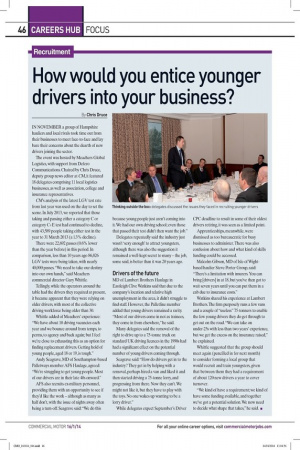How would you entice younger drivers into your business?
Page 41

If you've noticed an error in this article please click here to report it so we can fix it.
By Chris Druce
IN NOVEMBER a group of Hampshire hauliers and local rivals took time out from their businesses to meet face-to-face and lay bare their concerns about the dearth of new drivers joining the sector.
The event was hosted by Meachers Global Logistics, with support from Defero Communications. Chaired by Chris Druce, deputy group news editor at CM, it featured 18 delegates comprising 11 local logistics businesses, as well as association, college and insurance representatives.
CMs analysis of the latest LGV test rate from last year was used on the day to set the scene. In July 2013, we reported that those taking and passing either a category C or category C+E test had continued to decline, with 43,589 people taking either test in the year to 31 March 2013 (a 1.3% decline).
There were 22,692 passes (0.6% lower than the year before) in this period. In comparison, less than 10 years ago 86,826 LGV tests were being taken, with nearly 40,000 passes. "We need to take our destiny into our own hands," said Meachers commercial director Gary Whittle.
Tellingly, while the operators around the table had the drivers they required at present, it became apparent that they were relying on older drivers, with most of the collective driving workforce being older than 30.
Whittle added of Meachers' experience: "We have about 10 driving vacancies each year and we bounce around from temps, to perms, to agency and back again; but I feel we're close to exhausting this as an option for finding replacement drivers. Getting hold of young people, aged 18 or 19, is tough."
Andy Seagrave, MD of Southampton-based Palletways member AFS Haulage, agreed: "We're struggling to get young people. Most of our drivers are in their late 40s onward." AFS also recruits ex-military personnel, providing them with an opportunity to see if they'd like the work — although as many as half don't, with the issue of nights away often being a turn-off. Seagrave said: "We do this
because young people just aren't coming into it. We had our own driving school; even those that passed their test didn't then want the job."
Delegates repeatedly said the industry just wasn't 'sexy enough' to attract youngsters, although there was also the suggestion it remained a well-kept secret to many — the job, some said, is better than it was 20 years ago. Drivers of the future
MD of Lambert Brothers Haulage in Eastleigh Clive Watkins said that due to the company's location and relative high unemployment in the area, it didn't struggle to find staff. However, the Palletline member added that young drivers remained a rarity. "Most of our drivers come in not as trainees, they come in from elsewhere," he said.
Many delegates said the removal of the right to drive up to a 7.5-tonne truck on standard UK driving licences in the 1990s had had a significant effect on the potential number of young drivers coming through.
Seagrave said: "How do drivers get in to the industry? They get in by helping with a removal, perhaps hired a van and liked it and then started driving a 7.5-tonne lorry, and progressing from there. Now they can't. We might not like it, but they have to play with the toys. No one wakes up wanting to be a lorry driver." While delegates expect September's Driver
CPC deadline to result in some of their oldest drivers retiring, it was seen as a limited point.
Apprenticeships, meanwhile, were dismissed as too bureaucratic for busy businesses to administer. There was also confusion about how and what kind of skills funding could be accessed.
Malcolm Gibson, MD of Isle of Wightbased haulier Steve Porter Group, said: "There's a limitation with insurers. You can bring [drivers] in at 18, but you've then got to wait seven years until you can put them in a cab due to insurance costs."
Watkins shared his experience at Lambert Brothers. The firm purposely runs a few vans and a couple of "useless" 7.5-tonners to enable the few young drivers they do get through to get out on the road. "We can take on under-25s with less than two years' experience, but we get the excess on the insurance raised," he explained.
Whittle suggested that the group should meet again (pencilled in for next month) to consider forming a local group that would recruit and train youngsters, given that between them they had a requirement of about 120 new drivers a year to cover turnover. "We kind of have a requirement; we kind of have some funding available, and together we've got a potential solution. We now need to decide what shape that takes," he said. •











































